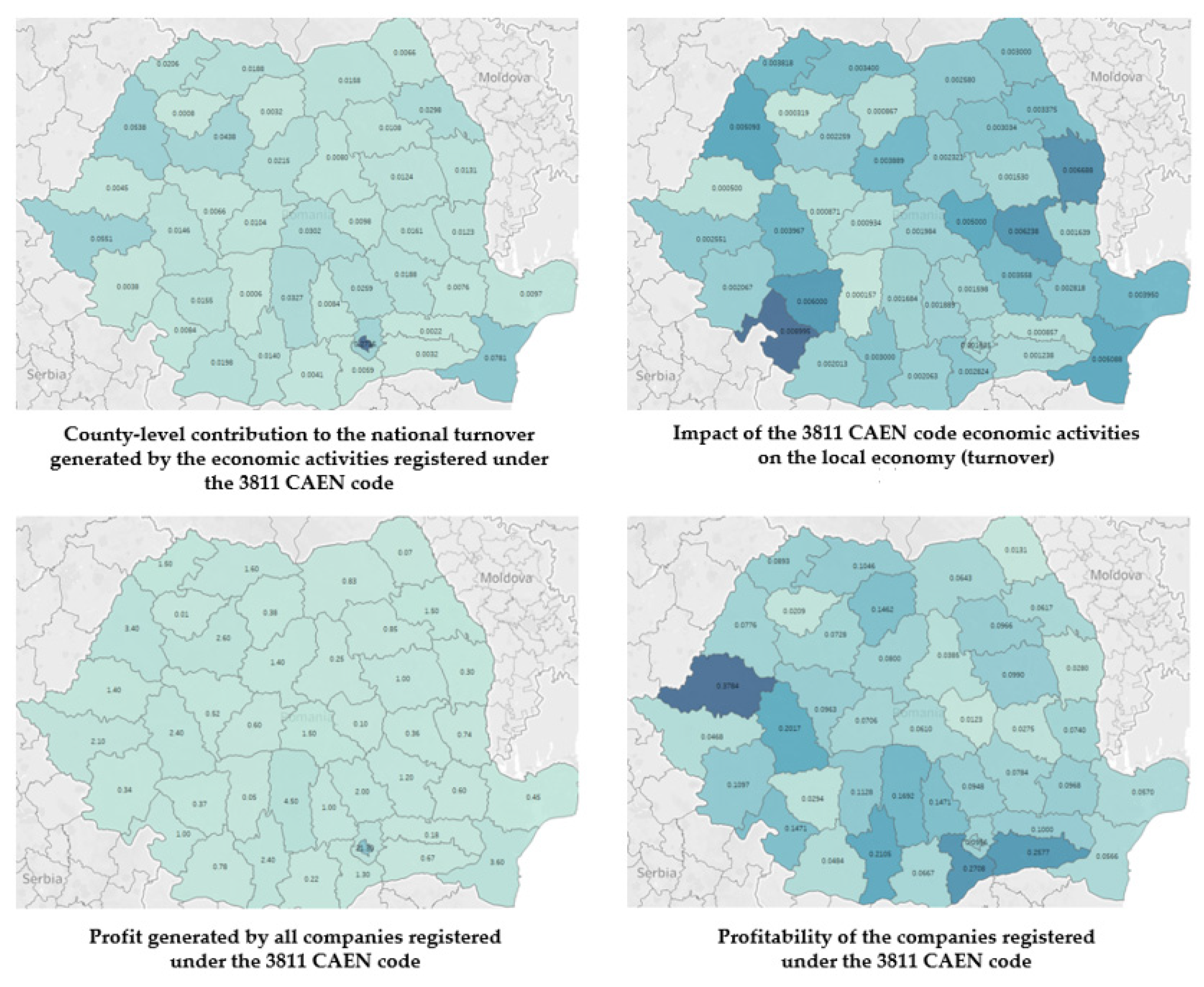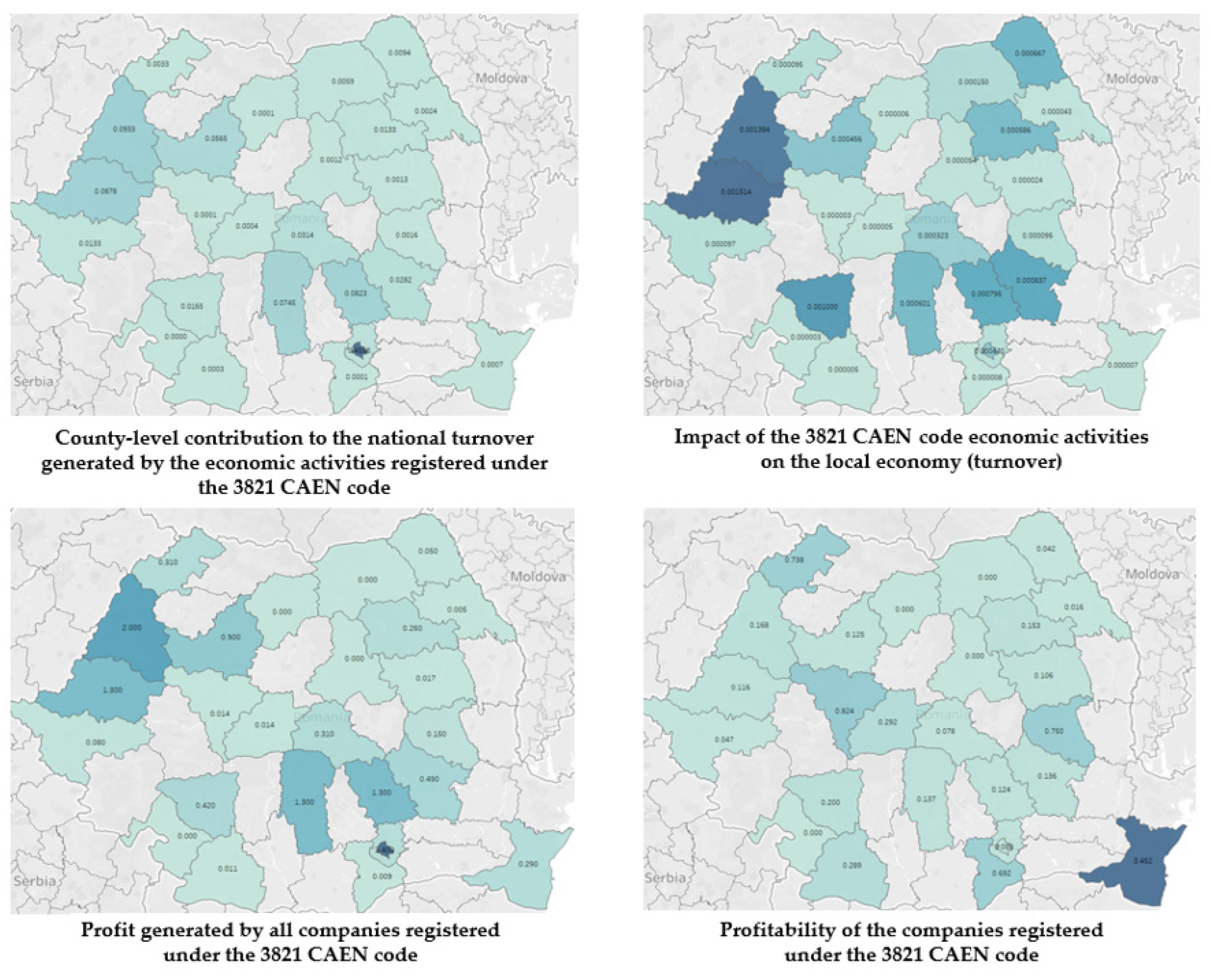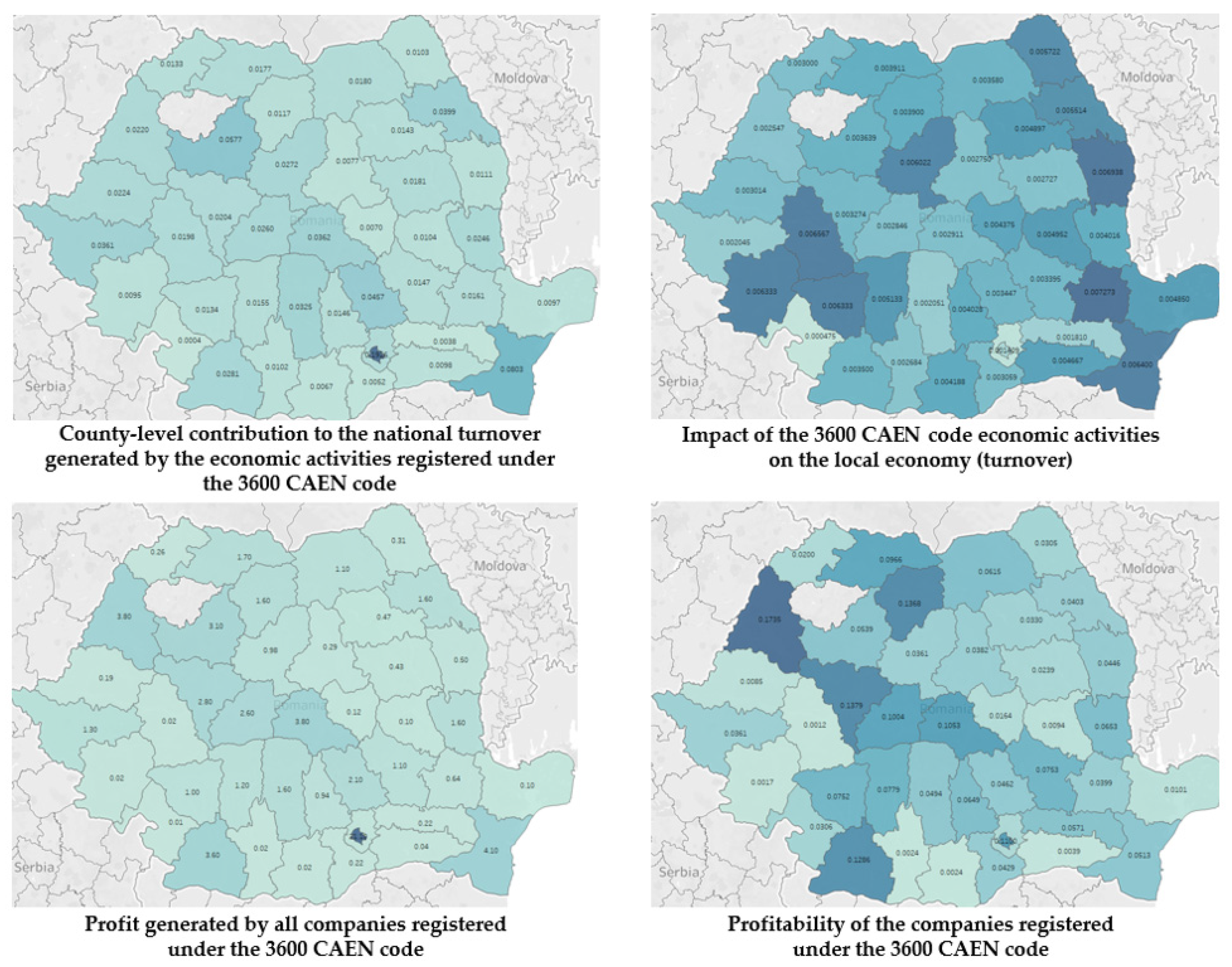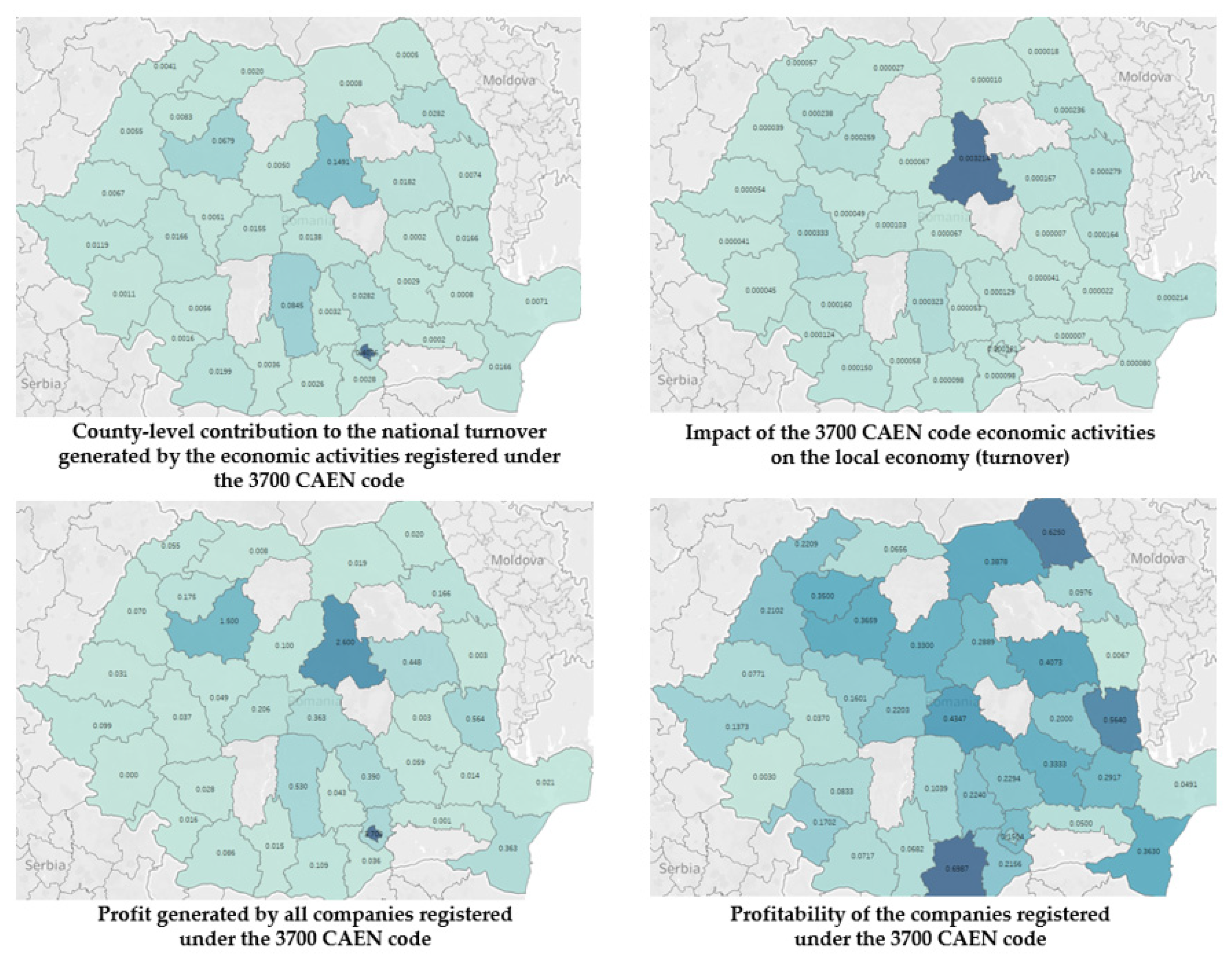Water, Energy, Food, Waste Nexus: Between Synergy and Trade-Offs in Romania Based on Entrepreneurship and Economic Performance
Abstract
:1. Introduction
2. Literature Review
2.1. The Water, Energy, Food, Waste (WEFW) Nexus: Economic Implications
2.2. The Role of Entrepreneurship in Water, Energy, Food and Waste (WEFW) Nexus
2.3. WEFW Nexus: The Imperative of a Multi-Intersectoral Approach in Romania in the European Context
3. Materials and Methods
4. Research Results
- (a)
- București (3.73), Sibiu (1.00), Caraș-Severin (0.87), Arad (0.82), Dolj (0.59), Hunedoara (0.55), Cluj (0.43), Harghita (0.41), Satu Mare (0.41), Brăila (0.40), Ilfov (0.39), Sălaj (0.38), Tulcea (0.32), Brașov (0.30), Argeș (0.26), Dâmbovița (0.25), Gorj (0.17), Bacău (0.17), Neamț (0.13), Galați (0.12), Teleorman (0.07), Buzău (0.07), Suceava (0.06), Bistrița-Năsăud (0.05), Maramureș (0.03), Iași (0.03), Giurgiu (0.03), Timiș (0.02), and Prahova (0.01);
- (b)
- Alba (−0.02), Ialomița (−0.02), Bihor (−0.07), and Constanța (−0.20).
5. Conclusions
Author Contributions
Funding
Institutional Review Board Statement
Informed Consent Statement
Data Availability Statement
Conflicts of Interest
References
- Hoff, H. Understanding the Nexus. In Background Paper for the Bonn 2011 Nexus Conference: The Water, Energy and Food Security Nexus; Stockholm Environment Institute: Stockholm, Sweden, 2011. [Google Scholar]
- Endo, A.; Yamada, M.; Miyashita, Y.; Sugimoto, R.; Ishii, A.; Nishijima, J.; Fujii, M.; Kato, T.; Hamamoto, H.; Kimura, M.; et al. Dynamics of Water–Energy–Food Nexus Methodology, Methods, and Tools. Curr. Opin. Environ. Sci. Health 2020, 13, 46–60. [Google Scholar] [CrossRef]
- Caiado Couto, L.; Campos, L.C.; da Fonseca-Zang, W.; Zang, J.; Bleischwitz, R. Water, Waste, Energy and Food Nexus in Brazil: Identifying a Resource Interlinkage Research Agenda through a Systematic Review. Renew. Sustain. Energy Rev. 2021, 138, 110554. [Google Scholar] [CrossRef]
- Ramos, E.P.; Howells, M.; Sridharan, V.; Engström, R.E.; Taliotis, C.; Mentis, D.; Gardumi, F.; De Strasser, L.; Pappis, I.; Balderrama, G.P.; et al. The Climate, Land, Energy, and Water Systems (CLEWs) Framework: A Retrospective of Activities and Advances to 2019. Environ. Res. Lett. 2020, 16, 033003. [Google Scholar] [CrossRef]
- Van Gevelt, T. The Water–Energy–Food Nexus: Bridging the Science–Policy Divide. Curr. Opin. Environ. Sci. Health 2020, 13, 6–10. [Google Scholar] [CrossRef]
- Yuan, M.-H.; Chiueh, P.-T.; Lo, S.-L. Measuring Urban Food-Energy-Water Nexus Sustainability: Finding Solutions for Cities. Sci. Total Environ. 2021, 752, 141954. [Google Scholar] [CrossRef] [PubMed]
- Andrei, J.V.; Gogonea, R.-M.; Zaharia, M.; Patrascu, A.; Bălăcescu, A.; Ladaru, R.G. A Critical Approach on Using Total Water Footprint of Agricultural Products as a Potential Sustainable Development Indicator. Teh. Vjesn. 2020, 27, 671–679. [Google Scholar] [CrossRef] [Green Version]
- Li, J.; Cui, J.; Sui, P.; Yue, S.; Yang, J.; Lv, Z.; Wang, D.; Chen, X.; Sun, B.; Ran, M.; et al. Valuing the Synergy in the Water-Energy-Food Nexus for Cropping Systems: A Case in the North China Plain. Ecol. Indic. 2021, 127, 107741. [Google Scholar] [CrossRef]
- Al-Saidi, M.; Hussein, H. The Water-Energy-Food Nexus and COVID-19: Towards a Systematization of Impacts and Responses. Sci. Total Environ. 2021, 779, 146529. [Google Scholar] [CrossRef] [PubMed]
- Andreucci, M.B.; Marvuglia, A. Investigating, Implementing and Funding Regenerative Urban Design in a Post-COVID-19 Pandemic Built Environment: A Reading Through Selected UN Sustainable Development Goals and the European Green Deal. In Rethinking Sustainability towards a Regenerative Economy; Andreucci, M.B., Marvuglia, A., Baltov, M., Hansen, P., Eds.; Future City; Springer: Cham, Switzerland, 2021; pp. 395–413. ISBN 978-3-030-71819-0. [Google Scholar]
- Tortorella, M.M.; Di Leo, S.; Cosmi, C.; Fortes, P.; Viccaro, M.; Cozzi, M.; Pietrapertosa, F.; Salvia, M.; Romano, S.A. Methodological Integrated Approach to Analyse Climate Change Effects in Agri-Food Sector: The TIMES Water-Energy-Food Module. Int. J. Environ. Res. Public Health 2020, 17, 7703. [Google Scholar] [CrossRef]
- Malagó, A.; Comero, S.; Bouraoui, F.; Kazezyılmaz-Alhan, C.M.; Gawlik, B.M.; Easton, P.; Laspidou, C. An Analytical Framework to Assess SDG Targets within the Context of WEFE Nexus in the Mediterranean Region. Resour. Conserv. Recycl. 2021, 164, 105205. [Google Scholar] [CrossRef]
- Mancini, G.; Luciano, A.; Bolzonella, D.; Fatone, F.; Viotti, P.; Fino, D. A Water-Waste-Energy Nexus Approach to Bridge the Sustainability Gap in Landfill-Based Waste Management Regions. Renew. Sustain. Energy Rev. 2021, 137, 110441. [Google Scholar] [CrossRef]
- European Commission. The European Green Deal; European Commission: Brussels, Belgium, 2019; Available online: https://eur-lex.europa.eu/resource.html?uri=cellar:b828d165-1c22-11ea-8c1f-01aa75ed71a1.0002.02/DOC_1&format=PDF (accessed on 1 July 2021).
- European Commission. A New Circular Economy Action Plan For a Cleaner and More Competitive Europe COM/2020/98 Final; European Commission: Brussels, Belgium, 2020; Available online: https://eur-lex.europa.eu/resource.html?uri=cellar:9903b325-6388-11ea-b735-01aa75ed71a1.0017.02/DOC_1&format=PDF (accessed on 1 July 2021).
- European Commission. Proposal for a Directive of the European Parliament and of the Council Amending Directive 2008/98/EC on Waste; European Commission: Brussels, Belgium, 2015; Available online: https://eur-lex.europa.eu/resource.html?uri=cellar:c2b5929d-999e-11e5-b3b7-01aa75ed71a1.0018.02/DOC_1&format=PDF (accessed on 1 July 2021).
- Gallego-Schmid, A.; Chen, H.-M.; Sharmina, M.; Mendoza, J.M.F. Links between Circular Economy and Climate Change Mitigation in the Built Environment. J. Clean. Prod. 2020, 260, 121115. [Google Scholar] [CrossRef]
- Velenturf, A.P.M.; Purnell, P. Principles for a Sustainable Circular Economy. Sustain. Prod. Consum. 2021, 27, 1437–1457. [Google Scholar] [CrossRef]
- Magazzino, C.; Mele, M.; Schneider, N.; Sarkodie, S.A. Waste Generation, Wealth and GHG Emissions from the Waste Sector: Is Denmark on the Path towards Circular Economy? Sci. Total Environ. 2021, 755, 142510. [Google Scholar] [CrossRef] [PubMed]
- Constantin, M.; Radulescu, I.D.; Andrei, J.V.; Chivu, L.; Erokhin, V.; Gao, T. A Perspective on Agricultural Labor Productivity and Greenhouse Gas Emissions in the Context of the Common Agricultural Policy Exigencies. Econ. Agric. 2021, 68, 53–67. [Google Scholar] [CrossRef]
- Lausselet, C.; Cherubini, F.; Oreggioni, G.D.; del Alamo Serrano, G.; Becidan, M.; Hu, X.; Rørstad, P.K.; Strømman, A.H. Norwegian Waste-to-Energy: Climate Change, Circular Economy and Carbon Capture and Storage. Resour. Conserv. Recycl. 2017, 126, 50–61. [Google Scholar] [CrossRef]
- Crecente, F.; Sarabia, M.; Teresa del Val, M. Climate Change Policy and Entrepreneurial Opportunities. Technol. Forecast. Soc. Chang. 2021, 163, 120446. [Google Scholar] [CrossRef]
- Pătărlăgeanu, S.R.; Constantin, M.; Strat, G.; Deaconu, M.E. Best Practices of Circular Activities in the Agri-Food Sector from the Netherlands and Romania; ASE Publishing House: Bucharest, Romania, 2021; ISBN 978-606-34-0375-0. [Google Scholar]
- United States National Intelligence Council. Global Trends 2030: Alternative Worlds; United States National Intelligence Council: Washingdon, DC, USA, 2021; ISBN 978-1-929667-21-5. Available online: https://www.dni.gov/files/documents/GlobalTrends_2030.pdf (accessed on 1 July 2021).
- Wada, Y.; Wisser, D.; Eisner, S.; Flörke, M.; Gerten, D.; Haddeland, I.; Hanasaki, N.; Masaki, Y.; Portmann, F.T.; Stacke, T.; et al. Multimodel Projections and Uncertainties of Irrigation Water Demand under Climate Change. Geophys. Res. Lett. 2013, 40, 4626–4632. [Google Scholar] [CrossRef] [Green Version]
- Abdullah, K. bin Use of Water and Land for Food Security and Environmental Sustainability. Irrig. Drain. 2006, 55, 219–222. [Google Scholar] [CrossRef]
- Cepoi, C.-O.; Bran, M.; Dinu, M. Investigating the Nexus between Fuel Ethanol and CO2 Emissions. A Panel Smooth Transition Regression Approach. J. Bus. Econ. Manag. 2020, 21, 1774–1792. [Google Scholar] [CrossRef]
- Armeanu, D.S.; Joldes, C.C.; Gherghina, S.C.; Andrei, J.V. Understanding the Multidimensional Linkages among Renewable Energy, Pollution, Economic Growth and Urbanization in Contemporary Economies: Quantitative Assessments across Different Income Countries’ Groups. Renew. Sustain. Energy Rev. 2021, 142, 110818. [Google Scholar] [CrossRef]
- Jean Vasile, A.; Raluca Andreea, I.; Popescu, G.H.; Elvira, N.; Marian, Z. Implications of Agricultural Bioenergy Crop Production and Prices in Changing the Land Use Paradigm—The Case of Romania. Land Use Policy 2016, 50, 399–407. [Google Scholar] [CrossRef] [Green Version]
- Subić, J.; Kjajić, N. Renewable Energy Use in Raspberry Production. Econ. Agric. 2017, 64, 821–843. [Google Scholar] [CrossRef] [Green Version]
- Valenti, F.; Toscano, A. A GIS-Based Model to Assess the Potential of Wastewater Treatment Plants for Enhancing Bioenergy Production within the Context of the Water–Energy Nexus. Energies 2021, 14, 2838. [Google Scholar] [CrossRef]
- Valenti, F.; Porto, S.M.C.; Dale, B.E.; Liao, W. Spatial Analysis of Feedstock Supply and Logistics to Establish Regional Biogas Power Generation: A Case Study in the Region of Sicily. Renew. Sustain. Energy Rev. 2018, 97, 50–63. [Google Scholar] [CrossRef]
- United Nations. Transforming Our World: The 2030 Agenda for Sustainable Development A/RES/70/1. 21 October 2015. Available online: https://sustainabledevelopment.un.org/content/documents/21252030%20Agenda%20for%20Sustainable%20Development%20web.pdf (accessed on 1 July 2021).
- Bazilian, M.; Rogner, H.; Howells, M.; Hermann, S.; Arent, D.; Gielen, D.; Steduto, P.; Mueller, A.; Komor, P.; Tol, R.S.J.; et al. Considering the Energy, Water and Food Nexus: Towards an Integrated Modelling Approach. Energy Policy 2011, 39, 7896–7906. [Google Scholar] [CrossRef]
- Ringler, C.; Bhaduri, A.; Lawford, R. The Nexus across Water, Energy, Land and Food (WELF): Potential for Improved Resource Use Efficiency? Curr. Opin. Environ. Sustain. 2013, 5, 617–624. [Google Scholar] [CrossRef]
- Leck, H.; Conway, D.; Bradshaw, M.; Rees, J. Tracing the Water–Energy–Food Nexus: Description, Theory and Practice. Geogr. Compass 2015, 9, 445–460. [Google Scholar] [CrossRef] [Green Version]
- Kibler, K.M.; Reinhart, D.; Hawkins, C.; Motlagh, A.M.; Wright, J. Food Waste and the Food-Energy-Water Nexus: A Review of Food Waste Management Alternatives. Waste Manag. 2018, 74, 52–62. [Google Scholar] [CrossRef]
- Garcia, D.J.; Lovett, B.M.; You, F. Considering Agricultural Wastes and Ecosystem Services in Food-Energy-Water-Waste Nexus System Design. J. Clean. Prod. 2019, 228, 941–955. [Google Scholar] [CrossRef]
- Udugama, I.A.; Petersen, L.A.H.; Falco, F.C.; Junicke, H.; Mitic, A.; Alsina, X.F.; Mansouri, S.S.; Gernaey, K.V. Resource Recovery from Waste Streams in a Water-Energy-Food Nexus Perspective: Toward More Sustainable Food Processing. Food Bioprod. Process. 2020, 119, 133–147. [Google Scholar] [CrossRef]
- Bryan, B.A.; Crossman, N.D.; Nolan, M.; Li, J.; Navarro, J.; Connor, J.D. Land Use Efficiency: Anticipating Future Demand for Land-Sector Greenhouse Gas Emissions Abatement and Managing Trade-Offs with Agriculture, Water, and Biodiversity. Glob. Chang. Biol. 2015, 21, 4098–4114. [Google Scholar] [CrossRef]
- Hafeez, M.; Yuan, C.; Shah, W.U.H.; Mahmood, M.T.; Li, X.; Iqbal, K. Evaluating the Relationship among Agriculture, Energy Demand, Finance and Environmental Degradation in One Belt and One Road Economies. Carbon Manag. 2020, 11, 139–154. [Google Scholar] [CrossRef]
- Hadian, S.; Madani, K. The Water Demand of Energy: Implications for Sustainable Energy Policy Development. Sustainability 2013, 5, 4674–4687. [Google Scholar] [CrossRef] [Green Version]
- Mancuso, G.; Perulli, G.D.; Lavrnić, S.; Morandi, B.; Toscano, A. SARS-CoV-2 from Urban to Rural Water Environment: Occurrence, Persistence, Fate, and Influence on Agriculture Irrigation. A Review. Water 2021, 13, 764. [Google Scholar] [CrossRef]
- Santeramo, F.G.; Lamonaca, E. Food Loss–Food Waste–Food Security: A New Research Agenda. Sustainability 2021, 13, 4642. [Google Scholar] [CrossRef]
- Dinu, M.; Pătărlăgeanu, S.R.; Petrariu, R.; Constantin, M.; Potcovaru, A.-M. Empowering Sustainable Consumer Behavior in the EU by Consolidating the Roles of Waste Recycling and Energy Productivity. Sustainability 2020, 12, 9794. [Google Scholar] [CrossRef]
- Istudor, N.; Ion, R.A.; Petrescu, I.E.; Hrebenciuc, A. Agriculture and the Twofold Relationship between Food Security and Climate Change. Evidence from Romania. Amfiteatrul Econ. 2019, 21, 285. [Google Scholar] [CrossRef]
- Luo, N.; Olsen, T.L.; Liu, Y. A Conceptual Framework to Analyze Food Loss and Waste within Food Supply Chains: An Operations Management Perspective. Sustainability 2021, 13, 927. [Google Scholar] [CrossRef]
- Büttner, T.; Grübler, A. The Birth of a “Green” Generation?: Generational Dynamics of Resource Consumption Patterns. Technol. Forecast. Soc. Chang. 1995, 50, 113–134. [Google Scholar] [CrossRef]
- Howarth, C.; Monasterolo, I. Understanding Barriers to Decision Making in the UK Energy-Food-Water Nexus: The Added Value of Interdisciplinary Approaches. Environ. Sci. Policy 2016, 61, 53–60. [Google Scholar] [CrossRef] [Green Version]
- Garcia, D.J.; You, F. Including Agricultural and Organic Waste in Food-Water-Energy-Waste Nexus Modelling and Decision-Making. In Computer Aided Chemical Engineering; Friedl, A., Klemeš, J.J., Radl, S., Varbanov, P.S., Wallek, T., Eds.; 28 European Symposium on Computer Aided Process Engineering; Elsevier: Amsterdam, The Netherlands, 2018; Volume 43, pp. 1475–1480. [Google Scholar]
- Rasul, G.; Sharma, B. The Nexus Approach to Water–Energy–Food Security: An Option for Adaptation to Climate Change. Clim. Policy 2016, 16, 682–702. [Google Scholar] [CrossRef] [Green Version]
- Orîndaru, A.; Popescu, M.-F.; Căescu, -C.; Botezatu, F.; Florescu, M.S.; Runceanu-Albu, C.-C. Leveraging COVID-19 Outbreak for Shaping a More Sustainable Consumer Behavior. Sustainability 2021, 13, 5762. [Google Scholar] [CrossRef]
- Rosenzweig, C.; Parry, M.L. Potential Impact of Climate Change on World Food Supply. Nature 1994, 367, 133–138. [Google Scholar] [CrossRef]
- Andrei, J.V.; Chivu, L.; Constantin, M.; Subić, J. Economic Aspects of International Agricultural Trade and Possible Threats to Food Security in the EU-27: A Systematic Statistical Approach. In Shifting Patterns of Agricultural Trade: The Protectionism Outbreak and Food Security; Erokhin, V., Tianming, G., Andrei, J.V., Eds.; Springer: Singapore, 2021; pp. 229–261. ISBN 9789811632600. [Google Scholar] [CrossRef]
- Mourad, M. Recycling, Recovering and Preventing “Food Waste”: Competing Solutions for Food Systems Sustainability in the United States and France. J. Clean. Prod. 2016, 126, 461–477. [Google Scholar] [CrossRef] [Green Version]
- Diaz-Ruiz, R.; Costa-Font, M.; López-i-Gelats, F.; Gil, J.M. Food Waste Prevention along the Food Supply Chain: A Multi-Actor Approach to Identify Effective Solutions. Resour. Conserv. Recycl. 2019, 149, 249–260. [Google Scholar] [CrossRef]
- Liljestrand, K. Logistics Solutions for Reducing Food Waste. Int. J. Phys. Distrib. Logist. Manag. 2017, 47, 318–339. [Google Scholar] [CrossRef]
- Falconer, R.E.; Haltas, I.; Varga, L.; Forbes, P.J.; Abdel-Aal, M.; Panayotov, N. Anaerobic Digestion of Food Waste: Eliciting Sustainable Water-Energy-Food Nexus Practices with Agent Based Modelling and Visual Analytics. J. Clean. Prod. 2020, 255, 120060. [Google Scholar] [CrossRef]
- Zhao, N.; You, F. Food-Energy-Water-Waste Nexus Systems Optimization for New York State under the COVID-19 Pandemic to Alleviate Health and Environmental Concerns. Appl. Energy 2021, 282, 116181. [Google Scholar] [CrossRef]
- Garcia, D.; You, F. Systems Engineering Opportunities for Agricultural and Organic Waste Management in the Food–Water–Energy Nexus. Curr. Opin. Chem. Eng. 2017, 18, 23–31. [Google Scholar] [CrossRef]
- Burnett, K.; Wada, C.A. Accounting for Externalities in the Water Energy Food Nexus. In The Water-Energy-Food Nexus: Human-Environmental Security in the Asia-Pacific Ring of Fire; Endo, A., Oh, T., Eds.; Global Environmental Studies; Springer: Singapore, 2018; pp. 261–272. ISBN 978-981-10-7383-0. [Google Scholar]
- Mansouri, S.S.; Udugama, I.A.; Cignitti, S.; Mitic, A.; Flores-Alsina, X.; Gernaey, K.V. Resource Recovery from Bio-Based Production Processes: A Future Necessity? Curr. Opin. Chem. Eng. 2017, 18, 1–9. [Google Scholar] [CrossRef]
- Eriksson, O.; Bisaillon, M.; Haraldsson, M.; Sundberg, J. Enhancement of Biogas Production from Food Waste and Sewage Sludge—Environmental and Economic Life Cycle Performance. J. Environ. Manage. 2016, 175, 33–39. [Google Scholar] [CrossRef] [PubMed]
- Kumar, A.; Samadder, S.R.; Kumar, N.; Singh, C. Estimation of the Generation Rate of Different Types of Plastic Wastes and Possible Revenue Recovery from Informal Recycling. Waste Manag. 2018, 79, 781–790. [Google Scholar] [CrossRef]
- Istudor, N.; Negrei, C. Circular Economy—Between Theory and Practice. Amfiteatru Econ. 2018, 48, 498–509. [Google Scholar]
- Iqbal, N.; Khan, A.; Gill, A.S.; Abbas, Q. Nexus between Sustainable Entrepreneurship and Environmental Pollution: Evidence from Developing Economy. Environ. Sci. Pollut. Res. 2020, 27, 36242–36253. [Google Scholar] [CrossRef] [PubMed]
- Albrecht, J. Environmental Issue Entrepreneurship: A Schumpeterian Perspective. Futures 2002, 34, 649–661. [Google Scholar] [CrossRef]
- Doh, J.P.; Tashman, P.; Benischke, M.H. Adapting to Grand Environmental Challenges Through Collective Entrepreneurship. Acad. Manag. Perspect. 2019, 33, 450–468. [Google Scholar] [CrossRef]
- George, G.; Merrill, R.K.; Schillebeeckx, S.J.D. Digital Sustainability and Entrepreneurship: How Digital Innovations Are Helping Tackle Climate Change and Sustainable Development. Entrep. Theory Pract. 2020, 1042258719899425. [Google Scholar] [CrossRef] [Green Version]
- Günzel-Jensen, F.; Rask, M. Combating Climate Change through Collaborations? Lessons Learnt from One of the Biggest Failures in Environmental Entrepreneurship. J. Clean. Prod. 2021, 278, 123941. [Google Scholar] [CrossRef]
- Bruner, P.; Harrison, R.; Horst, D.V.D. The Political Economy of Climate Change and Sustainable Entrepreneurship. Soc. Innov. Sustain. Entrep. 2018. [Google Scholar] [CrossRef]
- Trapp, C.T.C.; Kanbach, D.K. Green Entrepreneurship and Business Models: Deriving Green Technology Business Model Archetypes. J. Clean. Prod. 2021, 297, 126694. [Google Scholar] [CrossRef]
- González-Rodríguez, M.R.; Díaz-Fernández, M.C.; Simonetti, B. The Social, Economic and Environmental Dimensions of Corporate Social Responsibility: The Role Played by Consumers and Potential Entrepreneurs. Int. Bus. Rev. 2015, 24, 836–848. [Google Scholar] [CrossRef]
- Williams, S.; Schaefer, A. Small and Medium-Sized Enterprises and Sustainability: Managers’ Values and Engagement with Environmental and Climate Change Issues. Bus. Strategy Environ. 2013, 22, 173–186. [Google Scholar] [CrossRef] [Green Version]
- Maor, M. Policy Entrepreneurs in Policy Valuation Processes: The Case of the Coalition for Environmentally Responsible Economies. Environ. Plan. C Polit. Space 2017, 35, 1401–1417. [Google Scholar] [CrossRef]
- European Commission. Stepping up Europe’s 2030 Climate Ambition Investing in a Climate-Neutral Future for the Benefit of Our People; European Commission: Brussels, Belgium, 2020; Available online: https://eur-lex.europa.eu/legal-content/EN/TXT/PDF/?uri=CELEX:52020DC0562&from=EN (accessed on 1 July 2021).
- Zapletalová, V.; Komínková, M. Who Is Fighting against the EU’s Energy and Climate Policy in the European Parliament? The Contribution of the Visegrad Group. Energy Policy 2020, 139, 111326. [Google Scholar] [CrossRef]
- Ignat, R.; Constantin, M. Multidimensional Facets of Entrepreneurial Resilience during the COVID-19 Crisis through the Lens of the Wealthiest Romanian Counties. Sustainability 2020, 12, 10220. [Google Scholar] [CrossRef]
- Voicu-Dorobanțu, R.; Volintiru, C.; Popescu, M.-F.; Nerău, V.; Ștefan, G. Tackling Complexity of the Just Transition in the EU: Evidence from Romania. Energies 2021, 14, 1509. [Google Scholar] [CrossRef]
- Drăgoi, M.C.; Popescu, M.-F.; Andrei, J.V.; Mieilă, M. Developments of the Circular Economy in Romania under the New Sustainabilty Paradigm. Econ. Comput. Econ. Cybern. Stud. Res. 2018, 52, 125–138. [Google Scholar]
- Lee, S.-H.; Assi, A.T.; Daher, B.; Mengoub, F.E.; Mohtar, R.H. A Water-Energy-Food Nexus Approach for Conducting Trade-off Analysis: Morocco’s Phosphate Industry in the Khouribga Region. Hydrol. Earth Syst. Sci. 2020, 24, 4727–4741. [Google Scholar] [CrossRef]
- Cansino-Loeza, B.; Ponce-Ortega, J.M. Involving the Water–Energy–Food Nexus in Integrating Low-Income and Isolated Communities. ACS Sustain. Chem. Eng. 2019, 7, 1399–1418. [Google Scholar] [CrossRef]
- Kurian, M. The Water-Energy-Food Nexus: Trade-Offs, Thresholds and Transdisciplinary Approaches to Sustainable Development. Environ. Sci. Policy 2017, 68, 97–106. [Google Scholar] [CrossRef]
- Eckert, E.; Kovalevska, O. Sustainability in the European Union: Analyzing the Discourse of the European Green Deal. J. Risk Financ. Manag. 2021, 14, 80. [Google Scholar] [CrossRef]
- Simionescu, M.; Păuna, C.B.; Diaconescu, T. Renewable Energy and Economic Performance in the Context of the European Green Deal. Energies 2020, 13, 6440. [Google Scholar] [CrossRef]
- United Nations Climate Change Secretariat. Climate Action Now: Summary for Policymakers; United Nations Climate Change Secretariat: Bonn, Germany, 2018; Available online: https://unfccc.int/resource/climateaction2020/media/1308/unfccc_spm_2018.pdf (accessed on 1 July 2021).
- Weitz, N.; Strambo, C.; Kemp-Benedict, E.; Nilsson, M. Closing the Governance Gaps in the Water-Energy-Food Nexus: Insights from Integrative Governance. Glob. Environ. Chang. 2017, 45, 165–173. [Google Scholar] [CrossRef]
- Romanian National Institute for Statistics. Populația Conectată La Sistemele de Canalizare Şi Epurare a Apelor Uzate În Anul 2020; Romanian National Institute for Statistics: Bucharest, Romania, 2021. Available online: https://insse.ro/cms/sites/default/files/com_presa/com_pdf/sistem_canal_2020r.pdf (accessed on 1 July 2021).
- Chivu, L.; Constantin, M.; Privitera, D.; Andrei, J.V. Land Grabbing, Land Use, and Food Export Competitiveness: Bibliometric Study of a Paradigm Shift. In Shifting Patterns of Agricultural Trade: The Protectionism Outbreak and Food Security; Erokhin, V., Tianming, G., Andrei, J.V., Eds.; Springer: Singapore, 2021; pp. 143–164. ISBN 9789811632600. [Google Scholar] [CrossRef]
- European Commission. EU Energy Statistical Pocketbook and Country Datasheets; Luxembourg Publications Office of the European Union: Luxembourg, 2020; Available online: https://op.europa.eu/o/opportal-service/download-handler?identifier=87b16988-f740-11ea-991b-01aa75ed71a1&format=pdf&language=en&productionSystem=cellar&part= (accessed on 1 July 2021).
- Agora Energiewende and Ember. The European Power Sector in 2020. Up-to-Date Analysis on the Electricity Transition; Agora Energiewende and Ember: Berlin, Germany, 2021; Available online: https://static.agora-energiewende.de/fileadmin/Projekte/2021/2020_01_EU-Annual-Review_2020/A-EW_202_Report_European-Power-Sector-2020.pdf (accessed on 1 July 2021).
- Sterman, J.D. Sustaining Sustainability: Creating a Systems Science in a Fragmented Academy and Polarized World. In Sustainability Science: The Emerging Paradigm and the Urban Environment; Weinstein, M.P., Turner, R.E., Eds.; Springer: New York, NY, USA, 2012; pp. 21–58. ISBN 978-1-4614-3188-6. [Google Scholar]





| CAEN 2 Code | Name of CAEN 2 Code | Full Description of the Business Activity |
|---|---|---|
| 3600 | Water production, treatment, and supply | Water abstraction from rivers, lakes, and wells; treatment and distribution of water for industrial and domestic purposes; collection of rainwater; water distribution. It does not include operations for irrigation systems (agricultural purposes), wastewater treatment and transport via pipelines |
| 3700 | Sewage collection and treatment | Collection and transport of wastewater from industrial or communal activities; rainwater through sewers and sewage tanks; cleaning and maintenance of sewage systems, closed stormwater channels |
| 3821 | Treatment and disposal of non-hazardous waste | Treatment and disposal of solid or non-solid non-hazardous waste, including food waste; operation of landfills for non-hazardous waste; treatment and disposal of organic waste |
| 3811 | Collection of non-hazardous waste | Collection of non-hazardous solid waste (including household and food waste); collection of mixed but non-hazardous solid waste generated by households and enterprises |
| Indicator | Explanation |
|---|---|
| County-level contribution to the national turnover generated by economic activities registered under “X” CAEN code | Represents the turnover registered by all the active enterprises in a Romanian county with “X” CAEN code reported to the total turnover registered at national level under the “X” CAEN code |
| Impact of “X” CAEN code economic activities on the local economy | Represents the turnover registered by all the active enterprises in a Romanian county with “X” CAEN reported to the total turnover registered at county level under the “X” CAEN code |
| Profit generated by all companies registered with “X” CAEN code | Represents the total profit generated by the active enterprises registered with “X” CAEN code, reported in only in a specific Romanian county |
| Profitability of the companies registered with “X” CAEN code | Represents the total profit generated by the active enterprises registered with “X” CAEN code reported to the total turnover registered by the same enterprises, calculated at county level |
Publisher’s Note: MDPI stays neutral with regard to jurisdictional claims in published maps and institutional affiliations. |
© 2021 by the authors. Licensee MDPI, Basel, Switzerland. This article is an open access article distributed under the terms and conditions of the Creative Commons Attribution (CC BY) license (https://creativecommons.org/licenses/by/4.0/).
Share and Cite
Petrariu, R.; Constantin, M.; Dinu, M.; Pătărlăgeanu, S.R.; Deaconu, M.E. Water, Energy, Food, Waste Nexus: Between Synergy and Trade-Offs in Romania Based on Entrepreneurship and Economic Performance. Energies 2021, 14, 5172. https://doi.org/10.3390/en14165172
Petrariu R, Constantin M, Dinu M, Pătărlăgeanu SR, Deaconu ME. Water, Energy, Food, Waste Nexus: Between Synergy and Trade-Offs in Romania Based on Entrepreneurship and Economic Performance. Energies. 2021; 14(16):5172. https://doi.org/10.3390/en14165172
Chicago/Turabian StylePetrariu, Radu, Marius Constantin, Mihai Dinu, Simona Roxana Pătărlăgeanu, and Mădălina Elena Deaconu. 2021. "Water, Energy, Food, Waste Nexus: Between Synergy and Trade-Offs in Romania Based on Entrepreneurship and Economic Performance" Energies 14, no. 16: 5172. https://doi.org/10.3390/en14165172
APA StylePetrariu, R., Constantin, M., Dinu, M., Pătărlăgeanu, S. R., & Deaconu, M. E. (2021). Water, Energy, Food, Waste Nexus: Between Synergy and Trade-Offs in Romania Based on Entrepreneurship and Economic Performance. Energies, 14(16), 5172. https://doi.org/10.3390/en14165172







